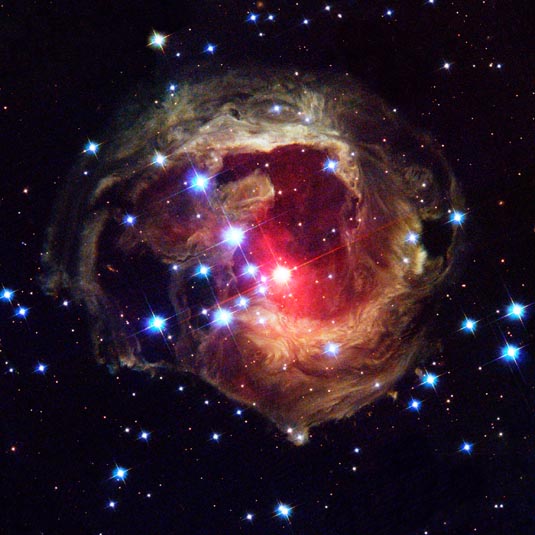
After Stellar Outburst
Description: Nova-like variable star and surrounding light echo
Position (J2000): R.A. 07h 04m 04.8s Dec. –03° 50' 50"
Constellation: Monoceros
Distance: 20,000 light-years (~6 kiloparsecs)
Dimensions: 2.4 arcminutes (13.7 light-years or 4.2 parsecs) wide.
Exposure Date(s): October 23, 2004
Exposure Time: 2.4 hours
Filters: F435W (B), F606W (V), F814W
Image Credit: NASA, ESA, and The Hubble Heritage Team (STScI/AURA)
Release Date: February 3, 2005
ABOUT THIS IMAGE:
The Hubble Space Telescope's latest image of the star V838 Monocerotis (V838 Mon) reveals dramatic changes in the illumination of surrounding dusty cloud structures. The effect, called a light echo, has been unveiling never-before-seen dust patterns ever since the star suddenly brightened for several weeks in early 2002.
The illumination of interstellar dust comes from the red supergiant star at the middle of the image, which gave off a pulse of light three years ago, somewhat similar to setting off a flashbulb in a darkened room. The dust surrounding V838 Mon may have been ejected from the star during a previous explosion, similar to the 2002 event.
The echoing of light through space is similar to the echoing of sound through air. As light from the stellar explosion continues to propagate outwards, different parts of the surrounding dust are illuminated, just as a sound echo bounces off of objects near the source, and later, objects further from the source. Eventually, when light from the back side of the nebula begins to arrive, the light echo will give the illusion of contracting, and finally it will disappear.
V838 Mon is located about 20,000 light-years away from Earth in the direction of the constellation Monoceros, placing the star at the outer edge of our Milky Way galaxy. The Hubble telescope has imaged V838 Mon and its light echo several times since the star's outburst. Each time Hubble observes the event, different thin sections of the dust are seen as the pulse of illumination continues to expand away from the star at the speed of light, producing a constantly changing appearance. During the outburst event whose light reached Earth in 2002, the normally faint star suddenly brightened, becoming 600,000 times more luminous than our Sun.
The new image of V838 Mon, taken in October 2004 with Hubble's Advanced Camera for Surveys, was prepared from images obtained through filters that isolate blue, green, and infrared light. These images have been combined to produce a full-color picture that approximates the true colors of the light echo and the very red star near the center.
What
is a light echo?
It
is light from a stellar explosion echoing off dust surrounding the star.
V838 Monocerotis produced enough energy in a brief flash to illuminate
surrounding dust, like a spelunker taking a flash picture of the walls
of an undiscovered cavern. The star presumably ejected the illuminated
dust shells in previous outbursts. Light from the latest outburst travels
to the dust and then is reflected to Earth. Because of this indirect path,
the light arrives at Earth months after light from the star that traveled
directly toward Earth.
Why
did the star produce this outburst?
Astronomers
do not fully understand the star's outburst. It was somewhat similar to
that of a nova, a more common stellar outburst. A typical nova is a normal
star that dumps hydrogen onto a compact white- dwarf companion star. The
hydrogen piles up until it spontaneously explodes by nuclear fusion —
like a titanic hydrogen bomb. This exposes a searing stellar core, which
has a temperature of hundreds of thousands of degrees Fahrenheit.
By contrast, V838 Monocerotis did not expel its outer layers. Instead, it grew enormously in size. Its surface temperature dropped to temperatures that were not much hotter than a light bulb. This behavior of ballooning to an immense size, but not losing its outer layers, is very unusual and completely unlike an ordinary nova explosion.
The outburst may represent a transitory stage in a star's evolution that is rarely seen. The star has some similarities to highly unstable aging stars called eruptive variables, which suddenly and unpredictably increase in brightness.
Are
light echos similar to sound echos?
The
echoing of light through space is similar to the echoing of sound through
air. As light from the stellar explosion continues to propagate outwards,
different parts of the surrounding dust are illuminated, just as a sound
echo bounces off of objects near the source, and later, objects further
from the source. Eventually, when light from the back side of the nebula
begins to arrive, the light echo will give the illusion of contracting,
and finally it will disappear.